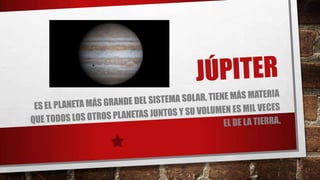
Júpiter
- 2. CARACTERÍSTICAS PRINCIPALES JÚPITER ES EL PLANETA CON MAYOR MASA DEL SISTEMA SOLAR: EQUIVALE A UNAS 2,48 VECES LA SUMA DE LAS MASAS DE TODOS LOS DEMÁS PLANETAS JUNTOS. A PESAR DE ELLO, NO ES EL PLANETA MÁS MASIVO QUE SE CONOCE: MÁS DE UN CENTENAR DE PLANETAS EXTRASOLARES QUE HAN SIDO DESCUBIERTOS TIENEN MASAS SIMILARES O SUPERIORES A LA DE JÚPITER. JÚPITER TAMBIÉN POSEE LA VELOCIDAD DE ROTACIÓN MÁS RÁPIDA DE LOS PLANETAS DEL SISTEMA SOLAR: GIRA EN POCO MENOS DE 10 HORAS SOBRE SU EJE
- 3. • • LA PEQUEÑA MANCHA ROJA EN MARZO DE 2006 SE ANUNCIÓ QUE SE HABÍA FORMADO UNA SEGUNDA MANCHA ROJA, APROXIMADAMENTE DE LA MITAD DEL TAMAÑO DE LA GRAN MANCHA ROJA. LA SEGUNDA MANCHA ROJA SE FORMÓ A PARTIR DE LA FUSIÓN DE TRES GRANDES ÓVALOS BLANCOS PRESENTES EN JÚPITER DESDE LOS AÑOS 1940, DENOMINADOS BC, DE Y FA, Y FUSIONADOS EN UNO SOLO ENTRE LOS AÑOS 1998 Y 2000, DANDO LUGAR A UN ÚNICO ÓVALO BLANCO DENOMINADO ÓVALO BLANCO BA,5 CUYO COLOR EVOLUCIONÓ HACIA LOS MISMOS TONOS QUE LA MANCHA ROJA A COMIENZOS DEL 2006. • • LA GRAN MANCHA ROJA EL CIENTÍFICO INGLÉS ROBERT HOOKE OBSERVÓ EN 1664 UNA GRAN FORMACIÓN METEOROLÓGICA QUE PODRÍA SER LA GRAN MANCHA ROJA (CONOCIDA EN INGLÉS POR LAS SIGLAS GRS). SIN EMBARGO NO PARECEN EXISTIR INFORMES POSTERIORES DE LA OBSERVACIÓN DE TAL FENÓMENO HASTA EL SIGLO XX. EN TODO CASO, VARÍA MUCHO TANTO DE COLOR COMO DE INTENSIDAD. LAS IMÁGENES OBTENIDAS POR EL OBSERVATORIO YERKES A FINALES DEL SIGLO XIX MUESTRAN UNA MANCHA ROJA ALARGADA, OCUPANDO EL MISMO RANGO DE LATITUDES PERO CON EL DOBLE DE EXTENSIÓN LONGITUDINAL. A VECES, ES DE UN COLOR ROJO FUERTE, Y REALMENTE MUY NOTABLE, Y EN OTRAS OCASIONES PALIDECE HASTA HACERSE INSIGNIFICANTE.